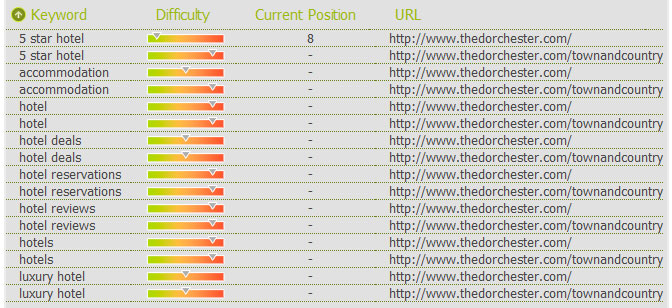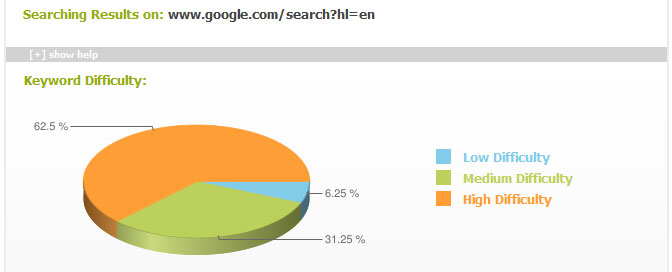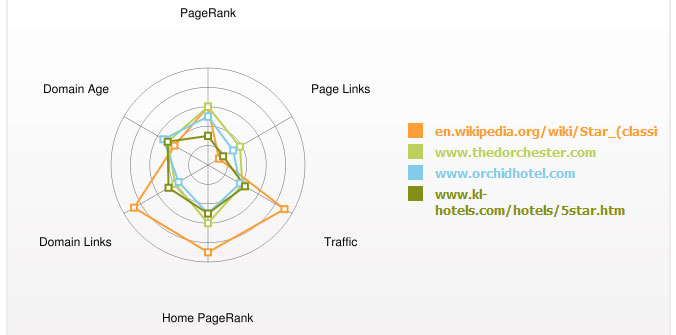Combine Keyword Research & Competitor Analysis to improve your SEO
 Most SEO Professionals and Online Marketers would agree that the creation of high quality content & services is the basic ingredient for a successful SEO & Online Marketing campaign. Still though just by providing great content & services and by optimizing your pages for the targeted keywords, it does not automatically lead to the increase of the search engine traffic.
Most SEO Professionals and Online Marketers would agree that the creation of high quality content & services is the basic ingredient for a successful SEO & Online Marketing campaign. Still though just by providing great content & services and by optimizing your pages for the targeted keywords, it does not automatically lead to the increase of the search engine traffic.
And when the On-page optimization fails to deliver the expected results, most people invest time and effort on Link Building campaigns, they fine-tune their internal linking architecture, they improve their website structure, they correct technical problems on their sites and they try several other techniques to improve their rankings. And then again in many cases they fail to achieve the expected results. So what goes wrong? Do they miss something that could help them rank first on Search Engine Results or do they simply focus on the wrong keywords?
The answer is quite straight forward; if the competition is not evaluated properly you will blow off your SEO campaign and you will waste your valuable resources while trying to achieve the wrong goals.
Focus on the right Goals
Either you are a webmaster or an SEO professional your target should be to increase your online sales or achieve your predefined goals (increase members/subscribers, increase conversion rates etc). This can be achieved by improving your website’s structure, your design, your texts and your call to actions, by reducing the conversion barriers and of course by driving high targeted traffic to your website. In this article we will focus on the last part.
Generic vs Targeted Keywords
As we have thoroughly discussed in the past, a successful SEO campaign should focus both on Generic and on Targeted terms. Targeted terms generally are long-tailed queries that are less popular and competitive but drive more targeted traffic to the websites (example: “luxury hotel in santorini”). On the other hand, generic terms are usually shorter queries that are really popular and competitive but they drive less targeted traffic (example: “hotel”).

One of the most common mistakes that webmasters make is that they try to rank mainly for generic popular terms that are supposed to increase significantly their traffic. Thus they spend all of their resources trying to rank first for their generic “trophy” keywords without evaluating the competition. Of course due to the intensity of the competition they don’t manage to rank anywhere near the first page and thus they don’t get any search engine traffic. Clearly in these cases, the decisions that were made during the Keyword Research and Keyword Selection processes were not correct and this can be the result of a sloppy Competitor Analysis.
Using Keyword Research & Competitor Analysis techniques
Keyword Research
As Dimitris Zotos has explained in the article “Keyword Research: The core of your SEO Strategy” before starting the Keyword Research you should take into account the nature of your product/service, your target audience and the keywords that your visitors are likely to type in order to find your product. You should be looking for both generic and targeted terms that are popular to the users and relevant to your website’s content. There are several Keyword Research tools that you can use in order to build your Keyword List. Even though this can also be done manually, it is highly recommended to use a reliable tool that will also provide you with several useful statistics and metrics for each keyword. These metrics will become really handy during Keyword Selection. Below we present a screenshot from a report that was generated by our Keyword Research tool.
As you can see above, after typing in the Keyword Research tool the seed term “hotel”, we receive a list of keywords that are related to the initial term along with several useful statistics such as the Relevance, the Query Popularity (How popular is the term), the estimated Search Results and graphs that show us how much the Search Volume of the keyword changed over time.
By creating many reports for several different “seed terms” we can build a detailed Keyword List that contains most of the important popular terms. Afterwards, by using the statistics that are provided in the list and by evaluating each term, we can select the most popular keywords that describe better our product/service and we eliminate the ones that have low Query Popularity and very few Search Results.
The above is a quite common SEO practice that most people use before optimizing their websites. Nevertheless this practice does not provide us with any information about how possible it is to achieve high rankings for those terms. In other words just by gathering the list of keywords, we get no idea of how difficult it is to rank for the terms. Thus before we finalize the Keyword List and before we start optimizing our texts for those terms, we need to screen the list and focus on the keywords for which we are likely to achieve high rankings.
Keyword Selection & Keyword Screening
As we saw in the article “Analyzing Search Engine Results: The fine art of SEO”, in order to determine if it is possible to achieve good rankings for a given term, we need to Analyze the Competition and compare directly our website pages with the ones that rank high on SERPs. We will be focusing more on factors that have to do with the Authority and the Strength of our competitors and we will care less for the on-page optimization, since this is something that we can easily copy on our website.
Unfortunately even if the Competitor Analysis technique is very effective, it is also extremely time consuming. Moreover despite the fact that we can automate the analysis by using the SERP Analysis tool, we still need to create hundreds of reports and evaluate every single of them.
To speed up this process we will use a different technique called Keyword Screening that will give us a clue of how difficult it is for a given page to rank on the first page of search engine results for a particular keyword. In order to achieve this we will use the Keyword Difficulty tool to screen our Keyword List and evaluate the competitiveness of each term.
Here is an example of how the Keyword Difficulty tool works. Suppose that you have completed your Keyword Research and that you have came up with the following keyword list:
- hotel deals
- luxury hotel
- hotel reviews
- 5 star hotel
- accommodation
- hotels
- hotel
- hotel reservations
Also suppose that your website is the thedorchester.com and that you want to check if it is possible to achieve high rankings by optimizing the following pages:
- http://www.thedorchester.com/
- http://www.thedorchester.com/townandcountry
What you need to do is to submit these data in Keyword Difficulty tool and select the Search Engine of your choice. In this example we will analyze the competition on Google.com. Below you will find a screenshot of the report:
The tool has analyzed for us the competition on SERPs (Search Engine Results Pages), it has compared our pages with the ones of our competitors by using numerous signals and it had determined how difficult it is for each submitted webpage to rank on the first page of Google.com for every keyword.
As we can see on the report, for the homepage of thedorcher.com it is not difficult to rank for the term “5 star hotel” (actually it is already in 8th position!). Moreover it is medium difficult to rank for terms such as “accommodation”, “hotel deals” and “luxury hotel” while it is very difficult to rank for “hotel”, “hotel reservations”, “hotel reviews” and “hotels”. Similarly we can explain the results of the second page of the website.
For those of you who are sceptical about how this tool works and how it performs the evaluation, the answer is simple: The tool works in exactly the same way as the SERP Analysis tool and it takes into account the same factors. The only reason why it does not provide all the data is to keep the report short and simple. Note that the detailed report of the analysis can be found by using the SERP Analysis tool. In other words the Keyword Difficulty tool executes several SERP Analysis reports and it summarizes the results on a single metric which is the difficulty. 🙂
In order to make the Keyword Selection, we need to understand how to explain the results of the Report. First of all the tool focuses primarily on factors that are more difficult to optimize such as the Link Quality, the Authority & Strength of the competitor, the Domain keywords, several off page metrics, etc and it does not focus on Keyword Optimization and On-page factors. If the difficulty of a keyword for a particular page is very high then we can easily conclude that it is highly unlikely to achieve good rankings with the particular page. If the difficulty is medium it means that if we optimize the page for the given keyword, we have good chances to rank on the first page of the results. Finally if the difficulty is low it means that we have very good chances of appearing high on the first page of the results.
By using this information we can screen the initial Keyword List and determine to which terms to focus and which keywords are more likely to drive traffic to our website. Moreover the tool will give us a clear view on which keywords to optimize in each page in order to maximize the organic traffic. Last but not least we should note that if a particular term has very high difficulty but still it is a very important term for our campaign, we should not remove it for the Keyword List. In such cases it is recommended to optimize the homepage or some other strong page for those main terms and use other SEO techniques in order to achieve the desired results.
Competitor Analysis
Once we screen our Keyword List, we will focus on the terms that we are more likely to achieve high rankings. At this point we need to understand the competition, evaluate their SEO campaigns and create a plan on how to achieve high rankings.
The procedure of the Competitor Analysis has been explained in the article “Analyzing Search Engine Results: The fine art of SEO”: We start by analyzing the competition on SERPs, and then we spot the pages that we can out-rank (the weak links of the chain) and we analyze their SEO campaigns. In the final step after evaluating their SEO campaigns, armed with the knowledge that we have acquired, we focus on the optimization of our website. The detailed steps of the process can be found on the above article.
What’s next?
In this guide we focused on how to perform Keyword Research and primarily how to select the terms that are more likely to increase your organic traffic based on your current SEO status. As you understand in order to maintain those rankings and of course in order to be able to achieve high placements for the terms that have been excluded from the list due to their difficulty, you need to continue improving and optimizing your website.
The creation of fresh high quality content will help you increase your number of pages and it will attract more links and visitors. Don’t forget to follow the best practices that we have discussed in the past and make sure you select your targeted keywords not only based on your wishful thoughts but also based on the real capabilities of your website.

 15 Comments
15 Comments






